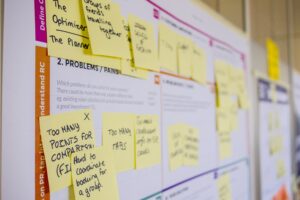Customer discovery is a process in business that’s essential for those looking to launch innovative products or services. It involves talking to potential customers to understand their needs, preferences, behaviors, and pain points. In this article, we’ll delve into the fundamental principles of customer discovery and explore why it’s beneficial for any business aiming to unleash innovation and stay ahead of the competition.
Understanding the Core Principles of Customer Discovery
Customer discovery should be conducted by any business that wants to succeed in today’s highly competitive market. It involves understanding your customers’ needs and preferences so that you can create products or services that meet their specific requirements. Before we dive into the benefits of customer discovery, let’s start by discussing its fundamental principles. For more information about how to put these principles into practice in the real world, check out our Step-by-Step Guide To Effective Customer Discovery.
The first key component of customer discovery is identifying your target audience. Without knowing who your ideal customer is, it’s impossible to create a product or service that meets their needs. By understanding your customers’ demographics, psychographics, and behavior patterns, you can create a customer persona that represents your target audience.
The second component of customer discovery is formulating hypotheses on the problems you’re solving. This involves identifying the problems that your target audience is facing and coming up with a solution to address it. You need to have a clear understanding of the problems and how your solutions can solve them.
The third component of customer discovery is validating the hypotheses by testing them on potential customers. This involves conducting market research and customer discovery interviews to gather feedback from your target audience. By doing this, you can confirm whether the problems you identified are real and whether your solutions are effective.
The fourth and final component of customer discovery is creating an effective solution to solve the problems validated by your target audience. This involves using the feedback you gathered from your target audience to refine your solutions and make them more effective. You need to be willing to adapt to changing consumer preferences and make changes to your solutions accordingly.
By following these principles, you can gain insights into what your customers want and develop a solution that meets their needs precisely. This process requires creativity, open-mindedness, and a willingness to adapt to changing consumer preferences. It’s important to remember that customer discovery is an ongoing process, and you need to continually gather feedback from your customers to refine your solution and stay ahead of the competition.
What are the Benefits of Customer Discovery
Customer discovery is can provide numerous benefits for businesses. Here are some of the ways in which customer discovery can help businesses:
- Identifying market demand: One of the primary benefits of customer discovery is that it can help businesses identify market demand. By interacting with potential customers, businesses can gain valuable insights into emerging trends and unmet needs or pain points that products or services can fulfill. This information can help businesses develop solutions that are tailored to the needs of their target market, increasing the chances of success.
- Reducing risk: Another benefit of customer discovery is that it can help businesses reduce the risk of failure. Investing time and money in developing a product or service without customer feedback can be a costly mistake. By engaging with potential customers early on in the development process, businesses can refine their solutions and ensure that they are meeting the needs of their target market. This can reduce the risk of failure and increase the chances of success.
- Staying competitive: By understanding how your customers behave and what they want, you can stay ahead of the competition by providing differentiated products and services that meet your customers’ needs. Customer discovery can help businesses identify gaps in the market that they can fill, as well as areas where they can differentiate themselves from their competitors.
- Building brand loyalty: Understanding your customers can help you build trust and loyalty by developing a product or service that meets their needs and exceeds their expectations. By engaging with potential customers early on in the development process, businesses can ensure that their solutions are tailored to the needs of their target market. This can help build brand loyalty and increase customer satisfaction.
- Improving customer retention: Customer discovery can also help businesses improve customer retention. By understanding the needs and pain points of their target market, businesses can develop solutions that address these issues. This can help improve customer satisfaction and reduce customer churn, leading to increased customer retention.
- Identifying new revenue streams: Finally, customer discovery can help businesses identify new revenue streams. By understanding the needs and pain points of their target market, businesses can develop solutions that address these issues. This can open up new opportunities for revenue generation and help businesses diversify their offerings.
By engaging with potential customers early on in the development process, businesses can ensure that their solutions are tailored to the needs of their target market, increasing the chances of success.
How to do the Customer Discovery Process
Now that you understand the benefits of customer discovery let’s look at how you can execute this process effectively. This is just meant to be an overview. Again, for a more detailed look at the customer discovery process with examples and suggestions, check out our Step-by-Step Guide To Effective Customer Discovery. The following steps are necessary:
- Identify your target audience: Who do you think your product or service is ideally suited for? Identifying your target audience helps you understand who your customers are and what they need. To identify your target audience, you need to define your product or service’s unique selling proposition and determine who would benefit the most from it. This requires research and analysis of market trends, consumer behavior, and competitor analysis.
- Create hypotheses: What problems are you solving? And what assumptions are you making about your customers’ needs? Creating hypotheses helps you define the problems you’re solving and the assumptions you’re making about your customers’ needs. Defining your solutions and assumptions requires a deep understanding of your target audience and their pain points. You can create hypotheses by conducting research, analyzing data, and brainstorming with your team.
- Conduct interviews and surveys: Ask open-ended questions to gather insights on your target audience’s behavior and pain points. The goal is not to sell but to gain a better understanding of the target market. Conducting interviews and surveys is a critical step in the customer discovery process. It helps you gather insights on your target audience’s behavior and pain points. The goal is not to sell but to gain a better understanding of the target market. You can conduct interviews and surveys in person, over the phone, or online. It’s essential to ask open-ended questions that encourage participants to share their true thoughts and feelings.
- Analyze and make conclusions: Review the feedback from the interviews and analyze them to validate or refute your hypotheses. Use the analyzed data to develop your product or service’s unique selling proposition. Reviewing interviews and synthesizing the insights and information you pull from them helps you validate or invalidate your hypotheses and gain insights into your target audience’s needs. You can analyze the data using various tools and techniques, such as data visualization, statistical analysis, and qualitative analysis. The analyzed data can help you develop your product or service’s unique selling proposition.
- Iterate and refine: Based on customer feedback and continuous iterations, refine your product or service until you reach market fit. Iterating and refining your product or service is a crucial step in the customer discovery process. It helps you improve your product or service based on customer feedback and continuous iterations. You can use various tools and techniques, such as prototyping, user testing, and A/B testing, to iterate and refine your product or service. The goal is to reach market fit, where your product or service meets your target audience’s needs and expectations.
By following these steps, businesses can optimize their products and services to meet customers’ needs and stay ahead of the competition. The customer discovery process is an ongoing process that requires continuous research, analysis, and refinement to ensure your product or service remains relevant and valuable to your target audience.
How can Software Help with Customer Discovery
Customer discovery is not an easy task, it requires a lot of effort, time, and resources. Fortunately, software can help businesses streamline the customer discovery process and make it more efficient and effective.
Innovation Within’s Discovery Platform is a comprehensive solution that encompasses all the necessary tools to effectively hypothesize ideas, conduct and synthesize interviews, and validate your concepts. With our platform, you have everything you need in one place, eliminating the need to juggle multiple software tools.
Hypothesize
Our Discovery Platform provides robust features to help you formulate and refine your ideas. You can brainstorm and hypothesize potential solutions, leveraging our intuitive interface and collaboration tools. By centralizing the ideation process within the platform, you can easily organize and develop your concepts with efficiency and clarity.
Interviews and Insights
The Discovery Platform empowers you to conduct interviews with precision and efficiency. You can seamlessly engage with your target audience, capturing valuable insights and perspectives. Through our platform, you can synthesize interview data, identify patterns and trends, and derive actionable insights that inform your decision-making process. This streamlined approach saves you time and resources, enabling you to focus on generating impactful solutions.
Validation
Validating your ideas is crucial, and our Discovery Platform offers the means to do so effectively. Within the platform, you can cite existing research tailored to your specific needs, collect data on customer demographics, preferences, behaviors, and pain points. By analyzing this data, you gain an understanding of your target audience, enabling you to validate your ideas and make informed decisions.
Why the Discovery Platform?
Our all-in-one Discovery Platform removes the complexities of managing separate software tools, providing a seamless and integrated experience for idea formulation, interview execution, and idea validation. With Innovation Within, you have the ultimate resource to drive innovation, uncover meaningful insights, and develop solutions that truly meet your customers’ needs and expectations.
Conclusion
Customer discovery is a critical for businesses looking to launch innovative products or services. By understanding the core principles of customer discovery, businesses can unlock a range of benefits that include identifying market demand, reducing risks, staying competitive, and building brand loyalty. The process involves identifying a target audience, forming a hypothesis, validating the problem’s hypothesis by testing it with potential customers, creating a salient solution, and refining the product based on customer feedback. By incorporating The Discovery Platform into the process, businesses can optimize their product offering and stay ahead of the competition.








